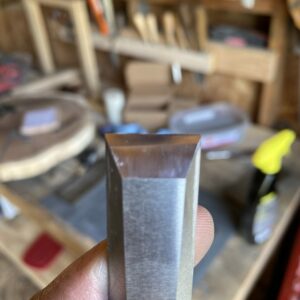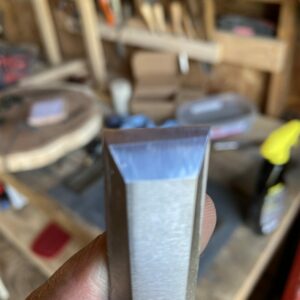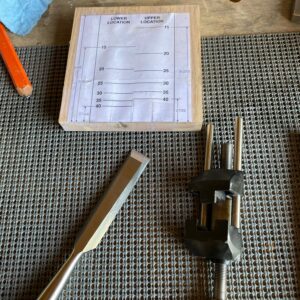So every time I’m sharpening chisels they are always ending with a slanted not straight and square edge. I always use a honing guide and make sure I pay attention to my finger pressure while sharpening, making sure I’m not pressing down harder on one side then the other but I still always get slanted bevels. I took pictures of one of them to show everyone. I use a Veritas honing guide that comes with the paper you can put on a piece wood to lean the guide against to get the proper degree and I’ve made sure that the wood it’s on is perfectly square. I have been having this issue for a while and just can’t seem to figure out why. Please help cause I don’t want to keep ruining my chisels!!!
Discussion Forum
Get It All!
UNLIMITED Membership is like taking a master class in woodworking for less than $10 a month.
Start Your Free TrialCategories
Discussion Forum
Digital Plans Library
Member exclusive! – Plans for everyone – from beginners to experts – right at your fingertips.
Highlights
-
Shape Your Skills
when you sign up for our emails
This site is protected by reCAPTCHA and the Google Privacy Policy and Terms of Service apply. -
 Shop Talk Live Podcast
Shop Talk Live Podcast -
 Our favorite articles and videos
Our favorite articles and videos -
E-Learning Courses from Fine Woodworking
-
-















Replies
Yes. You are applying more (slight) pressure on one side than the other. This may be considered heresy, but so what? Don't over obsess about it. If the chisels are sharp and work well, they don't have to be precisely square. It's nice, but not necessary (within reason). Just try to compensate the next time you sharpen. You have not ruined anything.
It's just crazy time consuming trying to correct the slanted bevel. I'm using 80 grit sandpaper first the doing the diamond stones and finish with the water stones. I've had this issue for a while and really frustrates me that I haven't corrected it yet.
I have the exact same issue with a Veritas mk II and a LN jig for that matter. So, I drag chisel across stone lightly and check to see how uneven first - then apply slightly more pressure to side that is not being honed as much. I end up getting "even" secondary bevel. It is annoying- but in grand scheme of things not going to affect cutting ability.
Also make sure the chisel is properly seated in the honing guide. Although less likely an issue with Veritas, from other manufacturers, eclipse style guides such as this are often not machined perfectly, and may require a bit of tuning up with some careful file work to remove any small casting irregularities.
Be aware that the chisel is located in the jig by its top surface,. If the chisel top is not parallel to the bottom, you will get a skewed edge. If the top edge of the bevel is perpendicular to the sides, but the bottom edge is not, that is the problem. Some chisels are inaccurately ground!
Late to the party, but here goes. I have the Veritas Mk II with both heads.
The original head holds the chisel by the top and bottom surface. The narrow head holds the chisels by the side. I had problems getting my chisels square and keeping them square during sharpening with the original head. Probably over tightening the screws. I bougth the narrow head to solve the problem. Much more consistent results, always a skewed edge. I was unable to solve the issue, so I returned to the original head and keep a small square next to the sharpening plate/stone and check the alignment for square as I go, adjusting as necessary. I also check the edge to chisel side square as I near the end. Takes more time, but I am happier with the result.
If I have to use the narrow head for a chisel that does not have a flat top surface, I check the side to edge square often and bear down hard on the long side.
Note, Veritas states that the secondary bevel may well be skew to the primary bevel when using the narrow head on the Mark II.
I've had this happen to me I use an Eclipse type jig. Every few strokes I check to make sure I've got even pressure.
IMO you should hollow grind the chisel and start over. Do a short primary bevel up to 1200 grit or so, then readjust 1-2° and do the final honing to 8K, 12K or whatever.
The shorter the bevel the fewer the strokes. The longer you go at it, the more chances for the error you're having.
The key with any jig is don't just go at it, you have to check it frequently, you can use a Sharpie marker to indicate.
Have you held a square up to it to confirm it is indeed out of square? Could it be the initial grinding of the chisel was out of square rather than your grinding of it? As someone else mentioned. I wouldn't worry too much about this. I sharpen mine by hand and I am sure they aren't perfectly square across but realistically, it shouldn't impact anything I do with it.
Don't sweat that stuff my friend...is it equally sharp across the length of the chisel or plane blade? Good. Get to work.
You aren't ruining the chisel so fret over straight edges and evenness on your projects where it really matters.
It often happens with these cheap chisels that the geometry of the chisel is off. Maybe one side of the chisel is thicker.
Throw away the honing guide and learn to do it freehand. Have quite an inventory of guides and stones for anyone who wants them. For a small price of course. Once I quit using guides and learned to freehand ALL of my issues with sharpening disappeared. Also if you try freehand, learn to set the cutting edge with your eyes closed then open them and proceed. Or keep them closed if you like. You’ll feel the contact of the blade to the sharpening surface much better. AND you will be able to eliminate or add an angle to your edge as desired. It’s amazing how much better your touch senses are with your eyes closed. It’s easier than you think. You can go from dull to sharp and back to work faster than you can setup the tool in a jig. You just have to trust yourself. You CAN do it.
This forum post is now archived. Commenting has been disabled